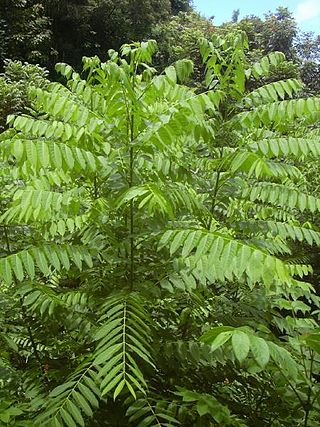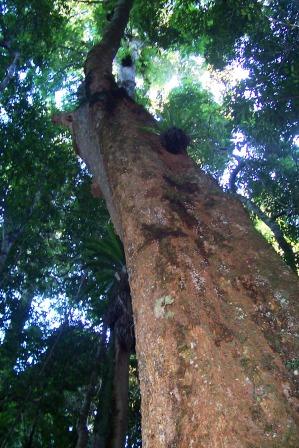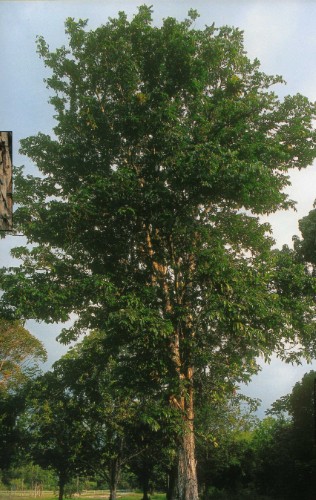
Mahogany is a straight-grained, reddish-brown timber of three tropical hardwood species of the genus Swietenia, indigenous to the Americas and part of the pantropical chinaberry family, Meliaceae. Mahogany is used commercially for a wide variety of goods, due to its coloring and durable nature. It is naturally found within the Americas, but has also been imported to plantations across Asia and Oceania. The mahogany trade may have begun as early as the 16th century and flourished in the 17th and 18th centuries. In certain countries, mahogany is considered an invasive species.
Melia or Melie may refer to:
African mahogany is a marketing name for several African trees whose wood has properties similar to New World mahogany species.

Custard apple is a common name for several fruits and may refer to Annonaceae, the custard apple family, which includes the following species referred to as custard apples:

Cedrela is a genus of several species in the mahogany family, Meliaceae. They are evergreen or dry-season deciduous trees with pinnate leaves, native to the tropical and subtropical New World, from southern Mexico south to northern Argentina.
Red bean is a common name for several plants and may refer to:
Mahogany refers to dark-colored wood from various types of tree.

A stringybark can be any of the many Eucalyptus species which have thick, fibrous bark. Like all eucalypts, stringybarks belong to the family Myrtaceae. In exceptionally fertile locations some stringybark species (in particular messmate stringybark can be very large, reaching over 80 metres in height. More typically, stringybarks are medium-sized trees in the 10 to 40 metre range.

Shorea is a genus of about 196 species of mainly rainforest trees in the family Dipterocarpaceae. The genus is named after Sir John Shore, the governor-general of the British East India Company, 1793–1798. The timber of trees of the genus is sold under the common names lauan, luan, lawaan, meranti, seraya, balau, bangkirai, and Philippine mahogany.

Entandrophragma cylindricum is a tree of the genus Entandrophragma of the family Meliaceae. It is commonly known as sapele or sapelli or sapele mahogany, as well as aboudikro, assi, and muyovu.
Beefwood is the name given to a number of Australian trees which have timber with a red colouration resembling raw beef as follows:

Wood-ear or tree ear, also translated wood jellyfish or tree jellyfish, can refer to a few similar-looking edible fungi used primarily in Chinese cuisine; these are commonly sold in Asian markets shredded and dried.
Tonewood refers to specific wood varieties used for woodwind or acoustic stringed instruments. The word implies that certain species exhibit qualities that enhance acoustic properties of the instruments, but other properties of the wood such as esthetics and availability have always been considered in the selection of wood for musical instruments. According to Mottola's Cyclopedic Dictionary of Lutherie Terms, tonewood is:
Wood that is used to make stringed musical instruments. The term is often used to indicate wood species that are suitable for stringed musical instruments and, by exclusion, those that are not. But the list of species generally considered to be tonewoods changes constantly and has changed constantly throughout history.

Turraeanthus africanus is a species of plant in the family Meliaceae, also known by the common names avodiré, apeya, engan, agbe, lusamba, wansenwa, African satinwood, and African white mahogany.
The name Persian lilac is commonly used for two different woody plants.

Dysoxylum fraserianum, commonly known as rosewood or rose mahogany, is a medium-sized to large tree native to New South Wales and Queensland. It is widely used with the purpose of street design and to provide shade in the eastern suburbs of Sydney. Rosewood ranges from the rainforest around eastern Australia from Bundaberg in Queensland to Wyong in New South Wales. At maturity, it can reach a height of 57 metres (200 ft). It is generally known for its strong scent of rose from its bark.
Indian mahogany is the common name for two species of trees in the family Meliaceae:
White mahogany is a common name for several trees and may refer to:

Carapa guianensis is a species of tree in the family Meliaceae, also known by the common names andiroba or crabwood.
Honduras mahogany is a common name for several trees and may refer to:
This page is based on this
Wikipedia article Text is available under the
CC BY-SA 4.0 license; additional terms may apply.
Images, videos and audio are available under their respective licenses.









